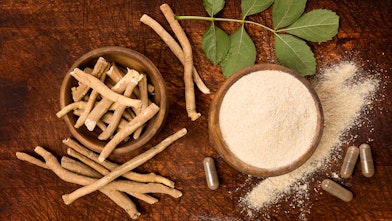Real Wasabi vs. Fake Wasabi
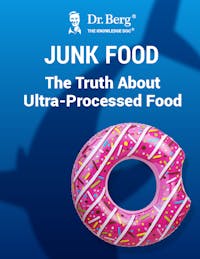
Junk Food: The Truth About Ultra-Processed Food
Learn about the detrimental impact of ultra-processed foods on health and well-being
Discover the top four dangerous hidden ingredients in everyday foods
Understand the health risks associated with consuming ultra-processed foods
Recognize misleading nutrition labels to make informed dietary choices
Get practical tips for choosing minimally processed whole foods for better health

Junk Food: The Truth About Ultra-Processed Food
Learn about the detrimental impact of ultra-processed foods on health and well-being
Discover the top four dangerous hidden ingredients in everyday foods
Understand the health risks associated with consuming ultra-processed foods
Recognize misleading nutrition labels to make informed dietary choices
Get practical tips for choosing minimally processed whole foods for better health

Junk Food: The Truth About Ultra-Processed Food
Learn about the detrimental impact of ultra-processed foods on health and well-being
Discover the top four dangerous hidden ingredients in everyday foods
Understand the health risks associated with consuming ultra-processed foods
Recognize misleading nutrition labels to make informed dietary choices
Get practical tips for choosing minimally processed whole foods for better health

Junk Food: The Truth About Ultra-Processed Food
Learn about the detrimental impact of ultra-processed foods on health and well-being
Discover the top four dangerous hidden ingredients in everyday foods
Understand the health risks associated with consuming ultra-processed foods
Recognize misleading nutrition labels to make informed dietary choices
Get practical tips for choosing minimally processed whole foods for better health

Junk Food: The Truth About Ultra-Processed Food
Learn about the detrimental impact of ultra-processed foods on health and well-being
Discover the top four dangerous hidden ingredients in everyday foods
Understand the health risks associated with consuming ultra-processed foods
Recognize misleading nutrition labels to make informed dietary choices
Get practical tips for choosing minimally processed whole foods for better health

Junk Food: The Truth About Ultra-Processed Food
Learn about the detrimental impact of ultra-processed foods on health and well-being
Discover the top four dangerous hidden ingredients in everyday foods
Understand the health risks associated with consuming ultra-processed foods
Recognize misleading nutrition labels to make informed dietary choices
Get practical tips for choosing minimally processed whole foods for better health

Junk Food: The Truth About Ultra-Processed Food
Learn about the detrimental impact of ultra-processed foods on health and well-being
Discover the top four dangerous hidden ingredients in everyday foods
Understand the health risks associated with consuming ultra-processed foods
Recognize misleading nutrition labels to make informed dietary choices
Get practical tips for choosing minimally processed whole foods for better health

Junk Food: The Truth About Ultra-Processed Food
Learn about the detrimental impact of ultra-processed foods on health and well-being
Discover the top four dangerous hidden ingredients in everyday foods
Understand the health risks associated with consuming ultra-processed foods
Recognize misleading nutrition labels to make informed dietary choices
Get practical tips for choosing minimally processed whole foods for better health

Junk Food: The Truth About Ultra-Processed Food
Learn about the detrimental impact of ultra-processed foods on health and well-being
Discover the top four dangerous hidden ingredients in everyday foods
Understand the health risks associated with consuming ultra-processed foods
Recognize misleading nutrition labels to make informed dietary choices
Get practical tips for choosing minimally processed whole foods for better health

Junk Food: The Truth About Ultra-Processed Food
Learn about the detrimental impact of ultra-processed foods on health and well-being
Discover the top four dangerous hidden ingredients in everyday foods
Understand the health risks associated with consuming ultra-processed foods
Recognize misleading nutrition labels to make informed dietary choices
Get practical tips for choosing minimally processed whole foods for better health

Junk Food: The Truth About Ultra-Processed Food
Learn about the detrimental impact of ultra-processed foods on health and well-being
Discover the top four dangerous hidden ingredients in everyday foods
Understand the health risks associated with consuming ultra-processed foods
Recognize misleading nutrition labels to make informed dietary choices
Get practical tips for choosing minimally processed whole foods for better health

Junk Food: The Truth About Ultra-Processed Food
Learn about the detrimental impact of ultra-processed foods on health and well-being
Discover the top four dangerous hidden ingredients in everyday foods
Understand the health risks associated with consuming ultra-processed foods
Recognize misleading nutrition labels to make informed dietary choices
Get practical tips for choosing minimally processed whole foods for better health
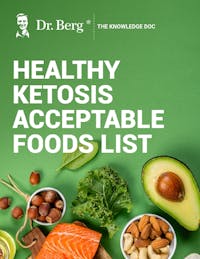
Healthy Keto Acceptable Foods List
Explore a comprehensive list of foods and beverages that align with Healthy Keto®
Identify which foods support fat-burning and metabolic health
Discover nutritious options for fats, proteins, and vegetables to support your health goals
Learn about common foods that aren’t Healthy Keto-approved

Healthy Keto Acceptable Foods List
Explore a comprehensive list of foods and beverages that align with Healthy Keto®
Identify which foods support fat-burning and metabolic health
Discover nutritious options for fats, proteins, and vegetables to support your health goals
Learn about common foods that aren’t Healthy Keto-approved

Healthy Keto Acceptable Foods List
Explore a comprehensive list of foods and beverages that align with Healthy Keto®
Identify which foods support fat-burning and metabolic health
Discover nutritious options for fats, proteins, and vegetables to support your health goals
Learn about common foods that aren’t Healthy Keto-approved

Healthy Keto Acceptable Foods List
Explore a comprehensive list of foods and beverages that align with Healthy Keto®
Identify which foods support fat-burning and metabolic health
Discover nutritious options for fats, proteins, and vegetables to support your health goals
Learn about common foods that aren’t Healthy Keto-approved

Healthy Keto Acceptable Foods List
Explore a comprehensive list of foods and beverages that align with Healthy Keto®
Identify which foods support fat-burning and metabolic health
Discover nutritious options for fats, proteins, and vegetables to support your health goals
Learn about common foods that aren’t Healthy Keto-approved

Healthy Keto Acceptable Foods List
Explore a comprehensive list of foods and beverages that align with Healthy Keto®
Identify which foods support fat-burning and metabolic health
Discover nutritious options for fats, proteins, and vegetables to support your health goals
Learn about common foods that aren’t Healthy Keto-approved

Healthy Keto Acceptable Foods List
Explore a comprehensive list of foods and beverages that align with Healthy Keto®
Identify which foods support fat-burning and metabolic health
Discover nutritious options for fats, proteins, and vegetables to support your health goals
Learn about common foods that aren’t Healthy Keto-approved

Healthy Keto Acceptable Foods List
Explore a comprehensive list of foods and beverages that align with Healthy Keto®
Identify which foods support fat-burning and metabolic health
Discover nutritious options for fats, proteins, and vegetables to support your health goals
Learn about common foods that aren’t Healthy Keto-approved

Healthy Keto Acceptable Foods List
Explore a comprehensive list of foods and beverages that align with Healthy Keto®
Identify which foods support fat-burning and metabolic health
Discover nutritious options for fats, proteins, and vegetables to support your health goals
Learn about common foods that aren’t Healthy Keto-approved

Healthy Keto Acceptable Foods List
Explore a comprehensive list of foods and beverages that align with Healthy Keto®
Identify which foods support fat-burning and metabolic health
Discover nutritious options for fats, proteins, and vegetables to support your health goals
Learn about common foods that aren’t Healthy Keto-approved

Healthy Keto Acceptable Foods List
Explore a comprehensive list of foods and beverages that align with Healthy Keto®
Identify which foods support fat-burning and metabolic health
Discover nutritious options for fats, proteins, and vegetables to support your health goals
Learn about common foods that aren’t Healthy Keto-approved

Healthy Keto Acceptable Foods List
Explore a comprehensive list of foods and beverages that align with Healthy Keto®
Identify which foods support fat-burning and metabolic health
Discover nutritious options for fats, proteins, and vegetables to support your health goals
Learn about common foods that aren’t Healthy Keto-approved
Real wasabi, or hon-wasabi, is made from fresh wasabi roots. In contrast, fake wasabi is typically made by blending horseradish, mustard, vinegar, and green food coloring.
Real wasabi paste is highly regarded for its aromatic, spicy flavor and is typically served alongside traditional Japanese dishes such as sushi and sashimi.
Learn why the wasabi served in your local sushi place is most likely imitation wasabi and why authentic Japanese wasabi is such a rare commodity.

What is wasabi?
Wasabi is a spicy and aromatic condiment traditionally made by finely grating wasabi rhizome—the underground stem of the wasabi plant.
Also known as Japanese horseradish, real wasabi has a distinct flavor often described as fragrant and spicy with a slight hint of sweetness.
The Wasabia japonica plant is native to Japan and belongs to the Brassicaceae family, making wasabi a close relative of radish and mustard plants.
Cultivating wasabi plants is challenging and requires specific temperatures, light exposure, and soil conditions. In addition, wasabi plants grow slowly and have a long maturation period.
It takes around two years for wasabi roots to grow, which explains why real wasabi is an exclusive and rare ingredient that’s expensive to produce.
Watch the video below to learn how to spot the difference between fake wasabi and the real stuff.
Real wasabi vs. fake wasabi
Because Japanese horseradish is notoriously challenging to grow, exported wasabi root can cost as much as $190 per pound.
To make wasabi cheaper and more widely accessible, imitation products that mimic real wasabi's texture, flavor, and appearance have become a popular alternative and are widely available in restaurants and supermarkets.
Fake wasabi is typically made by combining European horseradish—a much cheaper horseradish variety—mustard powder, vinegar, and fillers such as cornstarch or tapioca to thicken faux wasabi paste.
Real wasabi has a complex flavor profile with an intense, spicy kick and leaves a slightly sweet and refreshing aftertaste. It’s more nuanced and less overpowering than fake wasabi, which tends to have a strong, one-dimensional spiciness and a lingering burning sensation.
Freshly grated wasabi has a pale green color. On the other hand, fake wasabi often has a bright green tint achieved by adding artificial food coloring or spinach juice.
Compared to imitation wasabi, authentic wasabi loses its flavor quickly and is typically grated at the table and served immediately.
Fake wasabi has a much longer shelf-life and is generally available as a paste or powdered wasabi that can be mixed with water.
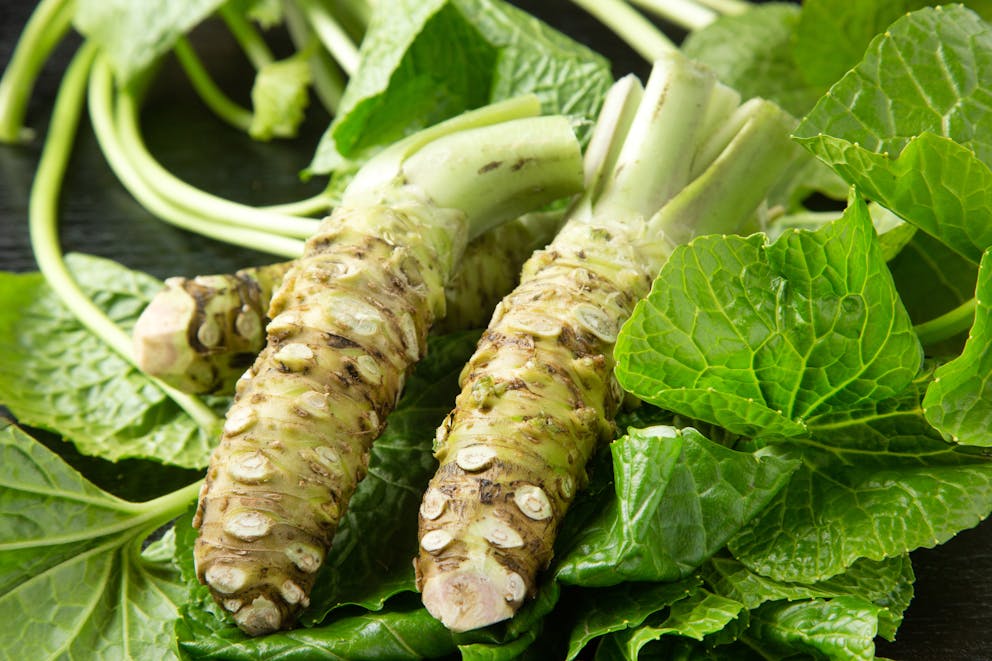
Six benefits of wasabi
The roots of wasabi plants have been used for culinary and medicinal purposes in Japan for centuries.
Wasabia japonica contains exceptionally high concentrations of health-promoting plant chemicals. In fact, real wasabi contains up to 3000 times more phytochemicals than cabbage.
Research published in Antioxidants found that “Wasabi contains two major components, isothiocyanate and allyl isothiocyanate, that exhibit anticancer, antioxidant, anti-inflammatory, neuroprotective, and antimicrobial properties.”
Here are six ways authentic Japanese wasabi can benefit your health!
1. Lowers inflammation
Bioactive compounds in wasabi may interfere with various pathways involved in regulating inflammation.
By inhibiting these pathways, wasabi is believed to suppress the production of inflammatory molecules and simultaneously activate immune cells to release anti-inflammatory agents.
Uncontrolled and chronic inflammation can significantly increase the risk of serious health conditions, including autoimmune diseases, cancer, heart disease, and arthritis.
2. Potent antioxidant
Wasabi contains potent phytonutrients and antioxidants, including isothiocyanates and flavonoids.
These phytochemicals protect your cells from oxidative damage by neutralizing harmful free radicals—unstable metabolic waste products.
Boosting dietary intake of antioxidants has been found to promote cellular health and may reduce the risk of premature aging and chronic diseases.
3. Antimicrobial agent
Have you ever wondered why wasabi is traditionally served with raw fish and seafood?
Isothiocyanates possess potent antimicrobial properties that inhibit the growth of certain bacteria and fungi, potentially reducing the risk of food poisoning.

4. Supports digestive health
Consuming wasabi with a meal can relieve digestive problems, such as indigestion, bloating, or gas.
Wasabi helps to stimulate the production of digestive enzymes, including amylase, lipase, and protease. These enzymes are crucial in breaking down carbohydrates, fats, and proteins.
5. May lower the risk of cancer
A study published in BioFactors found that wasabi has been shown to have potential anticancer effects.
Although more research is needed to confirm the role of wasabi in cancer prevention, isothiocyanates may inhibit the growth and proliferation of cancer cells and stimulate apoptosis, also known as programmed cell death, in abnormal cells.
6. Supports cognitive health
Wasabi's potent antioxidant and anti-inflammatory properties may help to protect brain cells from oxidative stress and inflammation, which are implicated in the development of cognitive decline and neurodegenerative diseases such as dementia and Alzheimer's disease.

Where to find real wasabi
Finding authentic Japanese wasabi can be challenging, and most wasabi paste available in the Western world is made from fake wasabi.
While both wasabi types provide a spicy kick, the flavors differ significantly between the two, and it’s worth seeking out Japanese horseradish if you have never eaten real wasabi.
Here are some places that may offer real wasabi:
Specialty Japanese grocery stores
Online retailers specializing in Japanese gourmet foods
High-end sushi bars or Japanese restaurants
Gourmet farmers markets
If you don’t have access to fresh Japanese wasabi, real wasabi powder can be a suitable alternative to fake wasabi paste.
It’s important to carefully read labels and look for products that state 100% Wasabia japonica powder and aren't marketed as wasabi-style or wasabi-flavored.
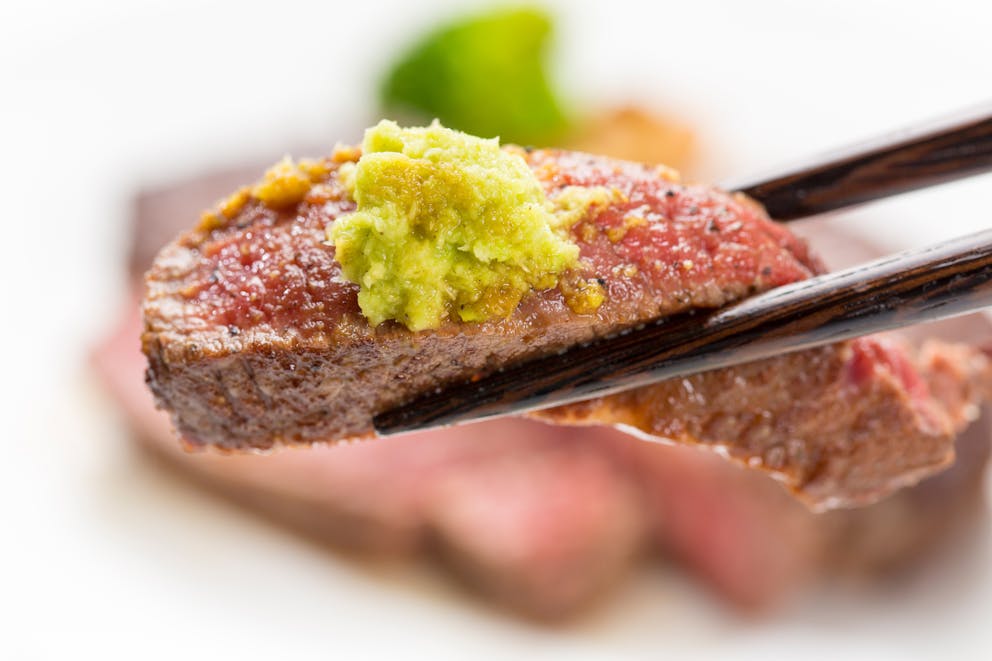
How to use wasabi on a keto diet
Not only does real wasabi taste better, but it’s also keto-friendly. Japanese horseradish is low in calories and is typically consumed in small amounts that won’t kick you out of ketosis.
“Fake wasabi may or may not be keto-friendly, depending on the exact ingredients,” explains Dr. Berg. “Many imitation wasabi products contain cornstarch, which isn’t considered keto-friendly.”
You may incorporate small amounts of fake wasabi, but be aware that one teaspoon of imitation wasabi paste contains around four net carbs and should be added to your daily net carb count.
Fresh Japanese horseradish or small amounts of paste made from real wasabi powder is an excellent keto-friendly condiment that can enhance the taste of various keto recipes.
The spice and flavor of wasabi complement the delicate taste of most fish, and you can enjoy wasabi with keto-friendly sushi rolls, sashimi, or other seafood dishes.
A wasabi paste dressing made with wasabi, soy sauce, and mayonnaise provides a spicy kick to low-carb lettuce or cauliflower wraps filled with grilled chicken, shrimp, or sliced vegetables.
Wasabi powder makes a flavorful rub for meat, poultry, and seafood, and you can grate wasabi root and use it as a topping for grilled steak, roasted salmon, or seared tuna.
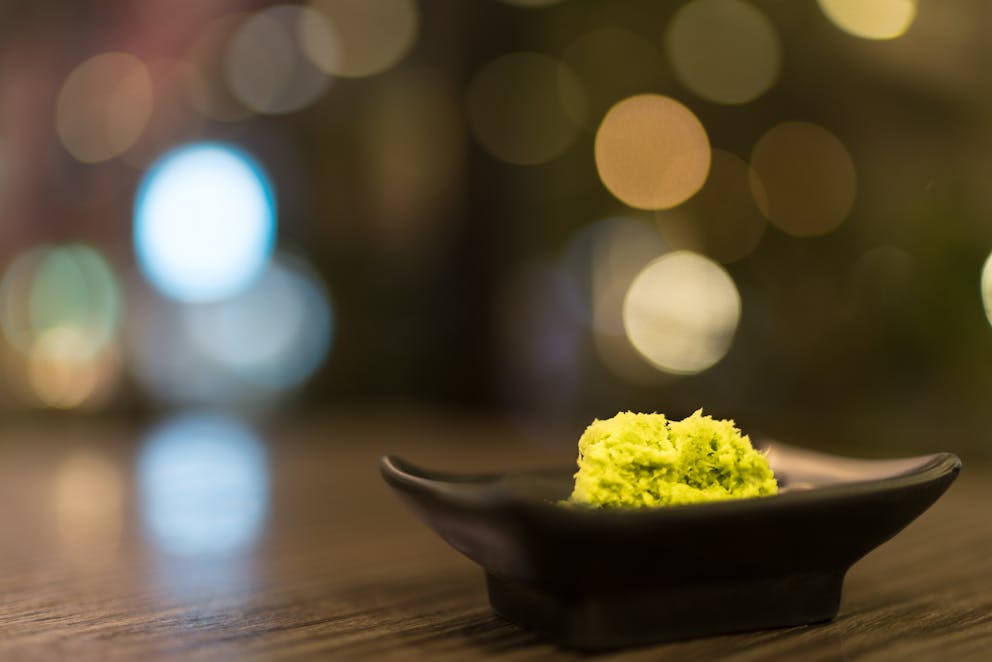
Key takeaways
Most wasabi available in the Western world is imitation wasabi made from a blend of horseradish, mustard, vinegar, and food coloring. While it does provide a distinct kick, it can’t be compared to the complex flavor of freshly grated Japanese horseradish.
And, what’s more, real wasabi has several health benefits due to its exceptionally high concentrations of isothiocyanates, a group of phytochemicals with potent anti-inflammatory, antioxidant, and antimicrobial properties.
However, finding real wasabi can be challenging, and choosing powdered wasabi made from 100% Wasabia japonica is a keto-friendly alternative to enhance the flavors of some of your favorite keto recipes.
FAQ
1. How can you tell the difference between real and fake wasabi?
Real wasabi is freshly prepared by grating the roots of Japanese horseradish. It has a light green color and smooth texture.
In contrast, fake wasabi has a bright green color and a much sharper flavor and is typically available in paste, tubes, or tins.
2. Why don't we use real wasabi?
Wasabi plants are challenging to grow, which limits the supply of fresh Japanese horseradish and explains the high costs of real wasabi. In addition, fresh wasabi loses its taste quickly and must be freshly prepared.
Fake wasabi, on the other hand, is much cheaper and has a longer shelf-life, making it more a practical and widely available condiment.
3. What is real wasabi made of?
Real wasabi is made by finely grating the roots of wasabi plants on a sharkskin grater and may be mixed with a small amount of water to achieve a smooth and creamy consistency.
4. What is fake wasabi made of?
Fake wasabi paste is typically made by blending horseradish, hot mustard, and vinegar. It’s often colored with synthetic food colorings or spinach juice to achieve a bright green paste.
Most imitation wasabi products also contain additives and fillers such as cornstarch or tapioca flour to thicken the paste.
5. Why is real wasabi so expensive?
Growing wasabi is notoriously challenging due to the very specific soil, water, and light requirements of wasabi plants. In addition, it can take up to two years for wasabi roots to mature, which explains why authentic Japanese horseradish is so expensive.
6. What does real wasabi taste like?
The taste of real wasabi is often described as aromatic and fragrant, with a spicy kick that dissipates quickly and leaves a subtle sweet aftertaste.
7. Does real wasabi taste like fake wasabi?
While both real and fake wasabi has a pungent and spicy flavor, freshly grated wasabi root has a complex taste that isn’t as one-dimensional and overpowering as most fake wasabi products.
8. Do sushi restaurants serve real wasabi or fake wasabi?
Most sushi restaurants serve fake wasabi paste due to the high cost and limited availability of fresh Japanese horseradish.
However, there are some Japanese gourmet restaurants and high-end sushi bars that offer freshly grated real wasabi.
9. Does real wasabi cost a lot?
Yes, real wasabi is very expensive to produce. Exported Japanese horseradish can cost as much as $190 per pound.
Previous blog
The Reason is You're Not Eating Enough...Next blog
8 Different Reasons for Poor SleepTags
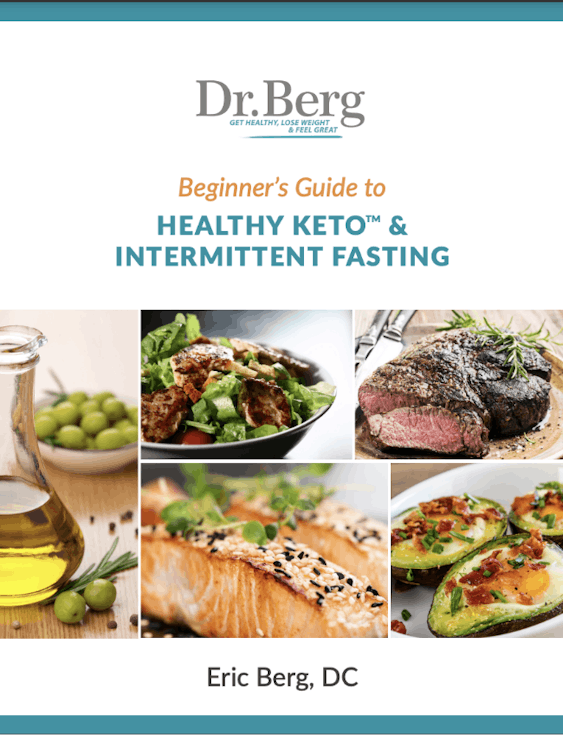
Popular
08/21/2024
55.7K views
02/23/2025
46.8K views
11/18/2024
281.1K views
03/18/2024
11/21/2022
